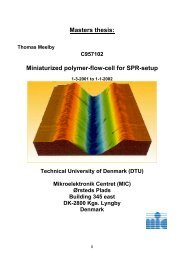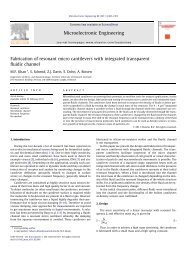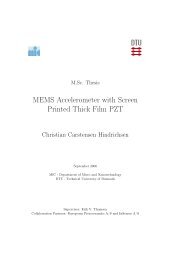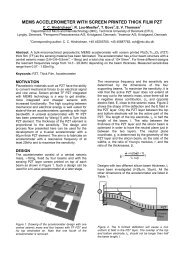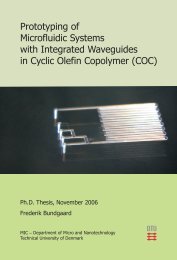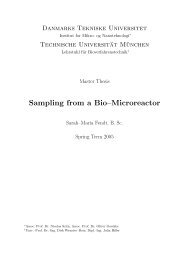Development of a Oxygen Sensor for Marine ... - DTU Nanotech
Development of a Oxygen Sensor for Marine ... - DTU Nanotech
Development of a Oxygen Sensor for Marine ... - DTU Nanotech
You also want an ePaper? Increase the reach of your titles
YUMPU automatically turns print PDFs into web optimized ePapers that Google loves.
Chapter 8<br />
Conclusion<br />
The primary goal <strong>for</strong> this project was to create a first generation oxygen<br />
sensor to compliment the Fish ’n Chip sensor. While a sensor have been<br />
created, it have not been tested, due to problems encountered during the<br />
projects, and as such the primary goal have not been fully fulfilled. However<br />
important steps towards a functioning dissolved oxygen sensor have been<br />
taken.<br />
Possible ways <strong>of</strong> measuring dissolved oxygen have been investigated, and<br />
a Clark type chosen.<br />
The theory behind the Clark sensor have been detailed, a further study<br />
into membrane materials and electrolytes could allow <strong>for</strong> improvements, as<br />
some <strong>of</strong> the potential optimization lies hidden here. Albeit this fall outside<br />
what knowledge <strong>of</strong> chemistry that I have.<br />
Various designs and the considerations behind them have been described,<br />
and with future results these should provide the basis <strong>for</strong> improving the<br />
sensor. This should also give a basic idea <strong>of</strong> what design outlay that is the<br />
most advantageous.<br />
The packaging concept, which proved to be the main problem despite not<br />
being within the focus <strong>of</strong> this project, have several flaws and will have to be<br />
given some thorough investigation.<br />
The temperature sensor seems to be working within the expected norms,<br />
and while not being revolutionary or even new, it is needed <strong>for</strong> the Clark<br />
sensor, due to the influence <strong>of</strong> temperature. An interesting aspect yet to<br />
explore however, is whether the Clark sensor influence it or vice versa.<br />
63



